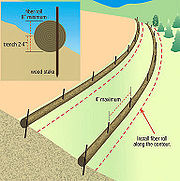
Fiber roll
Encyclopedia

Erosion control
Erosion control is the practice of preventing or controlling wind or water erosion in agriculture, land development and construction. Effective erosion controls are important techniques in preventing water pollution and soil loss.-Introduction:...
and sediment control
Sediment control
A sediment control is a practice or device designed to keep eroded soil on a construction site, so that it does not wash off and cause water pollution to a nearby stream, river, lake, or bay...
device used on construction
Construction
In the fields of architecture and civil engineering, construction is a process that consists of the building or assembling of infrastructure. Far from being a single activity, large scale construction is a feat of human multitasking...
sites to protect water quality
Water quality
Water quality is the physical, chemical and biological characteristics of water. It is a measure of the condition of water relative to the requirements of one or more biotic species and or to any human need or purpose. It is most frequently used by reference to a set of standards against which...
in nearby streams, rivers, lakes and bays from sediment erosion. It is made of straw
Straw
Straw is an agricultural by-product, the dry stalks of cereal plants, after the grain and chaff have been removed. Straw makes up about half of the yield of cereal crops such as barley, oats, rice, rye and wheat. It has many uses, including fuel, livestock bedding and fodder, thatching and...
, coconut
Coconut
The coconut palm, Cocos nucifera, is a member of the family Arecaceae . It is the only accepted species in the genus Cocos. The term coconut can refer to the entire coconut palm, the seed, or the fruit, which is not a botanical nut. The spelling cocoanut is an old-fashioned form of the word...
fiber or similar material formed into a tubular roll.
Each horizontal contour level row of fiber rolls is installed on slopes, ending with one at the base of the slope, below an active construction area before soil
Soil
Soil is a natural body consisting of layers of mineral constituents of variable thicknesses, which differ from the parent materials in their morphological, physical, chemical, and mineralogical characteristics...
disturbance (earth moving) begins. The space between each row of fiber roll is dependent on the steepness of the slope. The steeper the slope, the more rows of evenly spaced horizontal contour level fiber rolls are needed. Each fiber roll is installed on a horizontal contour level in shallow trenches 2 to 4 inches (5 to 10 cm) deep and fastened to the ground with wooden stakes.
Properly installed fiber rolls are effective at trapping sediment
Sediment
Sediment is naturally occurring material that is broken down by processes of weathering and erosion, and is subsequently transported by the action of fluids such as wind, water, or ice, and/or by the force of gravity acting on the particle itself....
, generally more effectively than straw bales. During rain storms, the rolls intercept surface stormwater
Stormwater
Stormwater is water that originates during precipitation events. It may also be used to apply to water that originates with snowmelt that enters the stormwater system...
runoff
Surface runoff
Surface runoff is the water flow that occurs when soil is infiltrated to full capacity and excess water from rain, meltwater, or other sources flows over the land. This is a major component of the water cycle. Runoff that occurs on surfaces before reaching a channel is also called a nonpoint source...
(but not concentrating or channeling the runoff) and reduce the velocity of flow. Water passes through a fiber roll while leaving behind the sediment on the uphill side of the roll, thereby reducing sediment erosion
Erosion
Erosion is when materials are removed from the surface and changed into something else. It only works by hydraulic actions and transport of solids in the natural environment, and leads to the deposition of these materials elsewhere...
.
See also
- GeosyntheticsGeosyntheticsGeosynthetics is the term used to describe a range of generally polymeric products used to solve civil engineering problems. The term is generally regarded to encompass eight main product categories: geotextiles, geogrids, geonets, geomembranes, geosynthetic clay liners, geofoam, geocells and...
- Geotechnical engineeringGeotechnical engineeringGeotechnical engineering is the branch of civil engineering concerned with the engineering behavior of earth materials. Geotechnical engineering is important in civil engineering, but is also used by military, mining, petroleum, or any other engineering concerned with construction on or in the ground...
- Nonpoint source pollutionNonpoint source pollutionNonpoint source pollution refers to both water and air pollution from diffuse sources. Nonpoint source water pollution affects a water body from sources such as polluted runoff from agricultural areas draining into a river, or wind-borne debris blowing out to sea. Nonpoint source air pollution...
- StormwaterStormwaterStormwater is water that originates during precipitation events. It may also be used to apply to water that originates with snowmelt that enters the stormwater system...
External links
- Erosion Control - a trade magazine for the erosion control and construction industries
- International Erosion Control Association - Professional Association, Publications, Training

